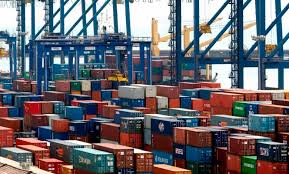Oil & Energy
US Sets Target To Achieve Pollution-Free Electricity Sector
The Joe Biden administration has set a target to achieve a carbon pollution-free electricity sector by 2035. While coal retirements have accelerated in recent years, replaced by soaring renewables capacity and increased natural gas-powered generation, the U.S. power sector is far from the track to be emissions-free.
Natural gas, which accounted for 39.8% of U.S. utility-scale electricity generation in 2022, isn’t going anywhere. In fact, it has helped balance power generation so far this year, as operators have raised gas-fired electricity supply to offset lower hydropower generation in the Pacific Northwest and lower wind speeds in the Midwest while delivering power amid increased demand during the summer heatwaves.
U.S. power generation from gas-fired plants jumped by 10% between January and August 20, 2023 compared to the same period of 2022, although overall electricity generation has declined by 2.1% so far in 2023, Gavin Maguire, Global Energy Transition Columnist at Reuters, reported, citing data compiled by Refinitiv.
The share of natural gas in electricity generation in America has averaged 40.4% year to date, compared to below 36% for the same period last year.
Electricity generation from coal continued to drop in all major U.S. power markets, while clean power generation was essentially flat as lower wind speeds and lower hydropower generation offset a surge in solar power output, the data and analysis showed.
The share of clean power, including nuclear and hydropower, inched up to 40.5% of America’s total power generation between January and August 2023, compared to 39.9% in the same period in 2022.
Despite a surge in renewables installations, power output from wind and hydro was lower than usual in the first half of 2023, due to lower wind speeds and drought in parts where hydropower accounts for a large part of power generation such as the Pacific Northwest.
Last year, power generation from renewable sources—wind, solar, hydro, biomass, and geothermal—surpassed coal-fired generation in the electric power sector for the first time ever, the Energy Information Administration (EIA) said, as coal plants are being retired and wind and solar installations boom.
Renewable generation had already surpassed nuclear generation for the first time in 2021 and continued to provide more electricity than nuclear generation last year, the administration noted earlier this year.
In renewables installations, the industry installed 5,218 megawatts (MW) of utility-scale solar, wind, and storage capacity in the second quarter of 2023, according to a report by the American Clean Power Association (ACP) earlier this month.
The newly installed generation, led by solar installations, made Q2 2023 the second-highest second quarter for clean power installations.
There is also a 13% increase in clean power projects under construction or in advanced development compared to the same time last year, the association said.
Cumulatively, operating clean power capacity in the U.S. is now more than 237 GW, accounting for 15.1% of electricity generated. Texas leads with 26.353 GW, or 18% of total operating U.S. clean power, followed by California with an 11% share and New York with 6% of operating clean power, ACP said.
Despite the growth in solar, wind, and battery installations this year, renewables power generation has been basically flat as natural gas has been the power source to pick up the slack when wind speeds were low or hydropower generation faltered due to lower water reservoir levels.
This summer, generation from natural gas, which remains the primary source of generation in the electric power sector, is set to increase by 3% compared to last year, the EIA said in June.
“Additional natural gas-fired generating capacity and favorable fuel costs are the primary drivers of our forecast increase in generation from natural gas this summer”, the administration added, noting that renewables and gas will see increased generation, reducing summer coal demand.
In May, the North American Electric Reliability Corporation (NERC) said in its summer reliability assessment that extreme weather this summer would strain the U.S. power grids, putting two-thirds of North America at risk of electricity shortfalls during periods of peak demand on the hottest days.
Among the reliability issues to monitor is the potential generator fuel delivery risk, NERC said, commenting that “The natural gas supply and infrastructure is vitally important to electric grid reliability, even as renewable generation satisfies more of our energy needs.
“Fuel supply and delivery infrastructure must be capable of meeting the ramp rates of natural-gas-fired generators as they balance the system when solar generation output declines”.
By: Tsvetana Paraskova
Paraskova reports for an online media outfit.
Oil & Energy
FG Woos IOCs On Energy Growth
The Federal Government has expressed optimism in attracting more investments by International Oil Companies (IOCs) into Nigeria to foster growth and sustainability in the energy sector.
This is as some IOCs, particularly Shell and TotalEnergies, had announced plans to divest some of their assets from the country.
Recall that Shell in January, 2024 had said it would sell the Shell Petroleum Development Company of Nigeria Limited (SPDC) to Renaissance.
According to the Minister of State for Petroleum Resources (Oil), Heineken Lokpobiri, increasing investments by IOCs as well as boosting crude production to enhancing Nigeria’s position as a leading player in the global energy market, are the key objectives of the Government.
Lokpobiri emphasized the Ministry’s willingness to collaborate with State Governments, particularly Bayelsa State, in advancing energy sector transformation efforts.
The Minister, who stressed the importance of cooperation in achieving shared goals said, “we are open to partnerships with Bayelsa State Government for mutual progress”.
In response to Governor Douye Diri’s appeal for Ministry intervention in restoring the Atala Oil Field belonging to Bayelsa State, the Minister assured prompt attention to the matter.
He said, “We will look into the issue promptly and ensure fairness and equity in addressing state concerns”.
Lokpobiri explained that the Bayelsa State Governor, Douyi Diri’s visit reaffirmed the commitment of both the Federal and State Government’s readiness to work together towards a sustainable, inclusive, and prosperous energy future for Nigeria.
While speaking, Governor Diri commended the Minister for his remarkable performance in revitalisng the nation’s energy sector.
Oil & Energy
Your Investment Is Safe, FG Tells Investors In Gas
The Federal Government has assured investors in the nation’s gas sector of the security and safety of their investments.
Minister of State for Petroleum Resources (Gas), Ekperikpe Ekpo, gave the assurance while hosting top officials of Shanghai Huayi Energy Chemical Company Group of China (HUAYI) and China Road and Bridge Corporation, who are strategic investors in Brass Methanol and Gas Hub Project in Bayelsa State.
The Minister in a statement stressed that Nigeria was open for investments and investors, insisting that present and prospective foreign investors have no need to entertain fear on the safety of their investment.
Describing the Brass project as one critical project of the President Bola Tinubu-led administration, Ekpo said.
“The Federal Government is committed to developing Nigeria’s gas reserves through projects such as the Brass Methanol project, which presents an opportunity for the diversification of Nigeria’s economy.
“It is for this and other reasons that the project has been accorded the significant concessions (or support) that it enjoys from the government.
“Let me, therefore, assure you of the strong commitment of our government to the security and safety of yours and other investments as we have continually done for similar Chinese investments in Nigeria through the years”, he added.
Ekpo further tasked investors and contractors working on the project to double their efforts, saying, “I want to see this project running for the good of Nigeria and its investors”.
Earlier in his speech, Leader of the Chinese delegation, Mr Zheng Bi Jun, said the visit to the country was to carry out feasibility studies for investments in methanol projects.
On his part, the Managing Director of Brass Fertiliser and Petrochemical Ltd, Mr Ben Okoye, expressed optimism in partnering with genuine investors on the project.
Oil & Energy
Oil Prices Record Second Monthly Gain
Crude oil prices recently logged their second monthly gain in a row as OPEC+ extended their supply curb deal until the end of Q2 2024.
The gains have been considerable, with WTI adding about $7 per barrel over the month of February.
Yet a lot of analysts remain bearish about the commodity’s prospects. In fact, they believe that there is enough oil supply globally to keep Brent around $81 this year and WTI at some $76.50, according to a Reuters poll.
Yet, like last year in U.S. shale showed, there is always the possibility of a major surprise.
According to the respondents in that poll, what’s keeping prices tame is, first, the fact that the Red Sea crisis has not yet affected oil shipments in the region, thanks to alternative routes.
The second reason cited by the analysts is OPEC+ spare capacity, which has increased, thanks to the cuts.
“Spare capacity has reached a multi-year high, which will keep overall market sentiment under pressure over the coming months”, senior analyst, Florian Grunberger, told Reuters.
The perception of ample spare capacity is definitely one factor keeping traders and analysts bearish as they assume this capacity would be put into operation as soon as the market needs it. This may well be an incorrect assumption.
Saudi Arabia and OPEC have given multiple signs that they would only release more production if prices are to their liking, and if cuts are getting extended, then current prices are not to OPEC’s liking yet.
There is more, too. The Saudis, which are cutting the most and have the greatest spare capacity at around 3 million barrels daily right now, are acutely aware that the moment they release additional supply, prices will plunge.
Therefore, the chance of Saudi cuts being reversed anytime soon is pretty slim.
Then there is the U.S. oil production factor. Last year, analysts expected modest output additions from the shale patch because the rig count remained consistently lower than what it was during the strongest shale boom years.
That assumption proved wrong as drillers made substantial gains in well productivity that pushed total production to yet another record.
Perhaps a bit oddly, analysts are once again making a bold assumption for this year: that the productivity gains will continue at the same rate this year as well.
The Energy Information Administration disagrees. In its latest Short-Term Energy Outlook, the authority estimated that U.S. oil output had reached a record high of 13.3 million barrels daily that in January fell to 12.6 million bpd due to harsh winter weather.
For the rest of the year, however, the EIA has forecast a production level remaining around the December record, which will only be broken in February 2025.
Oil demand, meanwhile, will be growing. Wood Mackenzie recently predicted 2024 demand growth at 1.9 million barrels daily.
OPEC sees this year’s demand growth at 2.25 million barrels daily. The IEA is, as usual, the most modest in its expectations, seeing 2024 demand for oil grow by 1.2 million bpd.
With OPEC+ keeping a lid on production and U.S. production remaining largely flat on 2023, if the EIA is correct, a tightening of the supply situation is only a matter of time. Indeed, some are predicting that already.
Natural resource-focused investors Goehring and Rozencwajg recently released their latest market outlook, in which they warned that the oil market may already be in a structural deficit, to manifest later this year.
They also noted a change in the methodology that the EIA uses to estimate oil production, which may well have led to a serious overestimation of production growth.
The discrepancy between actual and reported production, Goehring and Rozencwajg said, could be so significant that the EIA may be estimating growth where there’s a production decline.
So, on the one hand, some pretty important assumptions are being made about demand, namely, that it will grow more slowly this year than it did last year.
This assumption is based on another one, by the way, and this is the assumption that EV sales will rise as strongly as they did last year, when they failed to make a dent in oil demand growth, and kill some oil demand.
On the other hand, there is the assumption that U.S. drillers will keep drilling like they did last year. What would motivate such a development is unclear, besides the expectation that Europe will take in even more U.S. crude this year than it already is.
This is a much safer assumption than the one about demand, by the way. And yet, there are indications from the U.S. oil industry that there will be no pumping at will this year. There will be more production discipline.
Predicting oil prices accurately, even over the shortest of periods, is as safe as flipping a coin. With the number of variables at play at any moment, accurate predictions are usually little more than a fluke, especially when perceptions play such an outsized role in price movements.
One thing is for sure, though. There may be surprises this year in oil.
lrina Slav
Slav writes for Oilprice.com.
-
Niger Delta2 days ago
‘Agro-Processing, Key To Non-Oil Exports, Industrial Growth’
-

 Opinion2 days ago
Opinion2 days agoEssence of Easter
-

 News2 days ago
News2 days agoACF Felicitates Christians On Easter Celebration, Prays Nigeria Returns To Peace
-

 Education1 day ago
Education1 day agoEaster: VC Preaches Love, Compassion, Kindness
-

 News2 days ago
News2 days agoEdo Councils Restrict Movement Of Motorbike Riders
-

 Maritime1 day ago
Maritime1 day agoTwenty-Four-Hour Port Operations Achievable, If -Nweke
-

 Niger Delta2 days ago
Niger Delta2 days agoAfDB President Pledges Investment In C’River’s Health, Agric Sectors
-

 Opinion2 days ago
Opinion2 days agoNigeria Police And The “Miscreants” Theory

